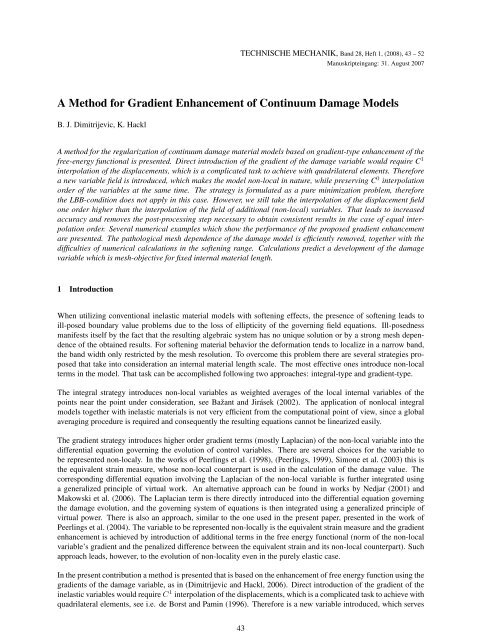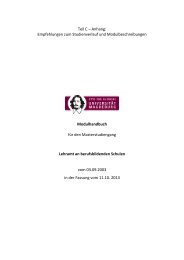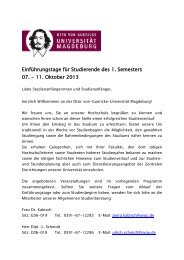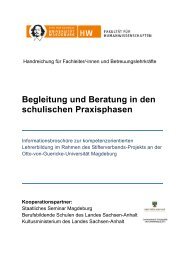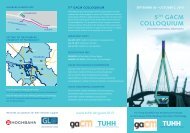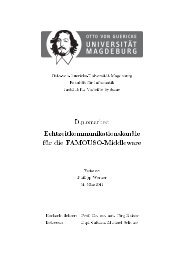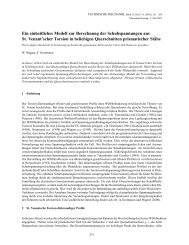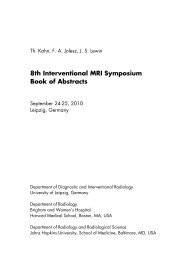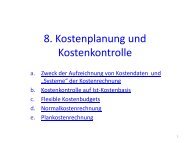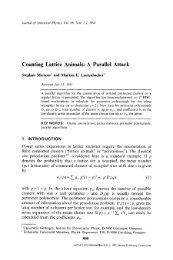A Method for Gradient Enhancement of Continuum Damage Models
A Method for Gradient Enhancement of Continuum Damage Models
A Method for Gradient Enhancement of Continuum Damage Models
Create successful ePaper yourself
Turn your PDF publications into a flip-book with our unique Google optimized e-Paper software.
TECHNISCHE MECHANIK, Band 28, Heft 1, (2008), 43 – 52<br />
Manuskripteingang: 31. August 2007<br />
A <strong>Method</strong> <strong>for</strong> <strong>Gradient</strong> <strong>Enhancement</strong> <strong>of</strong> <strong>Continuum</strong> <strong>Damage</strong> <strong>Models</strong><br />
B. J. Dimitrijevic, K. Hackl<br />
A method <strong>for</strong> the regularization <strong>of</strong> continuum damage material models based on gradient-type enhancement <strong>of</strong> the<br />
free-energy functional is presented. Direct introduction <strong>of</strong> the gradient <strong>of</strong> the damage variable would require C 1<br />
interpolation <strong>of</strong> the displacements, which is a complicated task to achieve with quadrilateral elements. There<strong>for</strong>e<br />
a new variable field is introduced, which makes the model non-local in nature, while preserving C 0 interpolation<br />
order <strong>of</strong> the variables at the same time. The strategy is <strong>for</strong>mulated as a pure minimization problem, there<strong>for</strong>e<br />
the LBB-condition does not apply in this case. However, we still take the interpolation <strong>of</strong> the displacement field<br />
one order higher than the interpolation <strong>of</strong> the field <strong>of</strong> additional (non-local) variables. That leads to increased<br />
accuracy and removes the post-processing step necessary to obtain consistent results in the case <strong>of</strong> equal interpolation<br />
order. Several numerical examples which show the per<strong>for</strong>mance <strong>of</strong> the proposed gradient enhancement<br />
are presented. The pathological mesh dependence <strong>of</strong> the damage model is efficiently removed, together with the<br />
difficulties <strong>of</strong> numerical calculations in the s<strong>of</strong>tening range. Calculations predict a development <strong>of</strong> the damage<br />
variable which is mesh-objective <strong>for</strong> fixed internal material length.<br />
1 Introduction<br />
When utilizing conventional inelastic material models with s<strong>of</strong>tening effects, the presence <strong>of</strong> s<strong>of</strong>tening leads to<br />
ill-posed boundary value problems due to the loss <strong>of</strong> ellipticity <strong>of</strong> the governing field equations. Ill-posedness<br />
manifests itself by the fact that the resulting algebraic system has no unique solution or by a strong mesh dependence<br />
<strong>of</strong> the obtained results. For s<strong>of</strong>tening material behavior the de<strong>for</strong>mation tends to localize in a narrow band,<br />
the band width only restricted by the mesh resolution. To overcome this problem there are several strategies proposed<br />
that take into consideration an internal material length scale. The most effective ones introduce non-local<br />
terms in the model. That task can be accomplished following two approaches: integral-type and gradient-type.<br />
The integral strategy introduces non-local variables as weighted averages <strong>of</strong> the local internal variables <strong>of</strong> the<br />
points near the point under consideration, see Bažant and Jirásek (2002). The application <strong>of</strong> nonlocal integral<br />
models together with inelastic materials is not very efficient from the computational point <strong>of</strong> view, since a global<br />
averaging procedure is required and consequently the resulting equations cannot be linearized easily.<br />
The gradient strategy introduces higher order gradient terms (mostly Laplacian) <strong>of</strong> the non-local variable into the<br />
differential equation governing the evolution <strong>of</strong> control variables. There are several choices <strong>for</strong> the variable to<br />
be represented non-localy. In the works <strong>of</strong> Peerlings et al. (1998), (Peerlings, 1999), Simone et al. (2003) this is<br />
the equivalent strain measure, whose non-local counterpart is used in the calculation <strong>of</strong> the damage value. The<br />
corresponding differential equation involving the Laplacian <strong>of</strong> the non-local variable is further integrated using<br />
a generalized principle <strong>of</strong> virtual work. An alternative approach can be found in works by Nedjar (2001) and<br />
Makowski et al. (2006). The Laplacian term is there directly introduced into the differential equation governing<br />
the damage evolution, and the governing system <strong>of</strong> equations is then integrated using a generalized principle <strong>of</strong><br />
virtual power. There is also an approach, similar to the one used in the present paper, presented in the work <strong>of</strong><br />
Peerlings et al. (2004). The variable to be represented non-locally is the equivalent strain measure and the gradient<br />
enhancement is achieved by introduction <strong>of</strong> additional terms in the free energy functional (norm <strong>of</strong> the non-local<br />
variable’s gradient and the penalized difference between the equivalent strain and its non-local counterpart). Such<br />
approach leads, however, to the evolution <strong>of</strong> non-locality even in the purely elastic case.<br />
In the present contribution a method is presented that is based on the enhancement <strong>of</strong> free energy function using the<br />
gradients <strong>of</strong> the damage variable, as in (Dimitrijevic and Hackl, 2006). Direct introduction <strong>of</strong> the gradient <strong>of</strong> the<br />
inelastic variables would require C 1 interpolation <strong>of</strong> the displacements, which is a complicated task to achieve with<br />
quadrilateral elements, see i.e. de Borst and Pamin (1996). There<strong>for</strong>e is a new variable introduced, which serves<br />
43
to transport the values <strong>of</strong> the inelastic variables across the element boundaries. That makes the model non-local<br />
in nature, while preserving C 0 interpolation order <strong>of</strong> the variables at the same time, see (Peerlings, 1999). The<br />
price to pay is an additional set <strong>of</strong> equations which has to be satisfied on the structural level, involving non-local<br />
variables and their derivatives.<br />
The paper is organized as follows. Section 2 introduces the enhancement in the <strong>for</strong>m <strong>of</strong> a pure minimization<br />
problem and presents the resulting global system <strong>of</strong> equations. Section 3 explains the constitutive model and<br />
Section 4 focuses on the finite element implementation. In Section 5 we show some representative simulation<br />
results. Conclusions are finally gathered in Section 6.<br />
2 <strong>Gradient</strong> <strong>Enhancement</strong> <strong>of</strong> a <strong>Continuum</strong> <strong>Damage</strong> Model<br />
In order to per<strong>for</strong>m the gradient enhancement, the starting point is a free energy function commonly used in<br />
continuum modeling <strong>of</strong> isotropic scalar damage:<br />
ψ = 1 f(d) (ɛ : C : ɛ) (1)<br />
2<br />
In (1) d represents a scalar variable that measures the degree <strong>of</strong> the material stiffness loss, and f(d) some appropriate<br />
function that is at least twice differentiable and satisfies the conditions:<br />
f(d) : R + → (0, 1] |<br />
{<br />
f(0) = 1,<br />
}<br />
lim f(d) = 0<br />
d→∞<br />
These conditions assure pure elastic behavior <strong>of</strong> the undamaged material and the complete material stiffness loss in<br />
the limiting case d → ∞. The guiding idea was to enhance the free energy function introducing a term involving<br />
the squared norm <strong>of</strong> the damage parameter gradient:<br />
¯ψ = 1 2 f(d) (ɛ : C : ɛ) + c d<br />
2 ‖∇d‖2 (3)<br />
Direct utilization <strong>of</strong> the <strong>for</strong>m (3) poses a very strong requirement on the displacement interpolation field: it is<br />
required that the displacement becomes C 1 continuous. An alternative simplified, but still relatively complicated<br />
approach can be to follow the super-element strategy <strong>of</strong> Abu Al-Rub and Voyiadjis (2005). In the present work,<br />
the modification <strong>of</strong> the enhanced free energy function is per<strong>for</strong>med introducing an additional variable field ϕ, as<br />
in (Dimitrijevic and Hackl, 2006), that should transfer the values <strong>of</strong> the damage parameter across the element<br />
boundaries thus making it non-local in nature. Besides the gradient term in the non-local variable ϕ, the modified<br />
free energy function includes a term which penalizes the difference between the non-local and local field:<br />
˜ψ = 1 2 f(d) (ɛ : C : ɛ) + c d<br />
2 ‖∇ϕ‖2 + β d<br />
2 [ϕ − γ 1d] 2 (4)<br />
In (4) parameter β d represents the energy penalizing the difference between non-local and local field, c d represents<br />
the gradient parameter that defines the degree <strong>of</strong> gradient regularization and the internal length scale. Finally a<br />
parameter γ 1 is used as a switch between the local and enhanced model: setting γ 1 = 0 and c d = 0 one obtains<br />
a local model, while setting γ 1 = 1 and c d ≠ 0 leads to the regularized model. Its introduction is motivated<br />
entirely by numerical reasons, so that we are able to obtain a non-singular tangent matrix in the limiting local case.<br />
Having the enhanced free energy function defined, the potential functional can be written in a standard manner:<br />
Π =<br />
∫<br />
Ω<br />
∫<br />
˜ψ dV − u · (ρb) dV −<br />
Ω<br />
∫<br />
∂Ω σ<br />
u · t dA (5)<br />
In (5) ρb stands <strong>for</strong> the <strong>for</strong>ce per unit volume <strong>of</strong> the body Ω and t <strong>for</strong> the external loading per unit surface <strong>of</strong> the<br />
boundary <strong>of</strong> the body ∂Ω σ . Minimization <strong>of</strong> the potential (5) with respect to the primal variables u and ϕ results<br />
in a system <strong>of</strong> equations that has to be solved globally:<br />
∫<br />
Ω<br />
δɛ : ∂ ˜ψ<br />
∂ɛ dV − ∫<br />
Ω<br />
δu · (ρb) dV −<br />
∫<br />
∂Ω σ<br />
δu · t dA = 0 ∀ δu (6)<br />
(2)<br />
44
∫<br />
Ω<br />
(δϕ {β d [ϕ − γ 1 d]} + c d [∇δϕ · ∇ϕ]) dV = 0 ∀ δϕ (7)<br />
The first equation (6) is the common principle <strong>of</strong> virtual work and there<strong>for</strong>e does not require special consideration.<br />
Attention should be paid to the second equation (7): minimization with respect to the non-local variable ϕ. In<br />
particular its second term should be analyzed. This volume integral can be trans<strong>for</strong>med using the theorem <strong>of</strong><br />
Gauß-Ostrogradski into one integral over boundary <strong>of</strong> the body and one volume integral involving a Laplacian<br />
term:<br />
∫<br />
∫<br />
∫<br />
c d [∇δϕ · ∇ϕ] dV = c d δϕ∇ϕ · n dA − c d δϕ ∇ 2 ϕ dV ∀ δϕ (8)<br />
Ω<br />
∂Ω<br />
Introducing a so-called natural boundary conditions <strong>of</strong> vanishing flux <strong>of</strong> the non-local variable across the boundary,<br />
as in de Borst and Pamin (1996), Peerlings et al. (1998), (Peerlings, 1999), Simone et al. (2003), Lorentz and<br />
Benallal (2005), the boundary term in (8) reduces to zero, leaving only the Laplacian volume term:<br />
∫<br />
∂Ω<br />
δϕ∇ϕ · n dA = 0<br />
⇒<br />
∫<br />
Ω<br />
c d [∇δϕ · ∇ϕ] dV<br />
Ω<br />
= −c d<br />
∫<br />
There<strong>for</strong>e the equation (7) can be expressed in an equivalent alternative <strong>for</strong>m:<br />
∫<br />
Ω<br />
Ω<br />
δϕ ∇ 2 ϕ dV ∀ δϕ (9)<br />
δϕ { β d [ϕ − γ 1 d] − c d ∇ 2 ϕ } dV = 0 (10)<br />
which leads to the second order differential equation governing the evolution <strong>of</strong> the variable ϕ :<br />
β d [ϕ − γ 1 d] − c d ∇ 2 ϕ = 0 (11)<br />
3 Local Constitutive Model<br />
The starting point in the consideration <strong>of</strong> the local constitutive model that results as a consequence <strong>of</strong> the proposed<br />
method <strong>for</strong> a gradient enhancement is the enhanced free energy function (4). Following standard thermodynamic<br />
consideration, driving <strong>for</strong>ces (stress tensor σ and damage conjugate q) are found:<br />
σ := ∂ ˜ψ<br />
∂ɛ<br />
= f(d) C : ɛ (12)<br />
q := − ∂ ˜ψ<br />
∂d = −1 2 f ′ (d) (ɛ : C : ɛ) + β d γ 1 [ϕ − γ 1 d]<br />
(13)<br />
} {{ }<br />
} {{ }<br />
q<br />
q NL<br />
L<br />
It is obvious that the stress tensor σ (12) maintains the <strong>for</strong>m as in the standard (unenhanced) damage model.<br />
Focusing on the damage conjugate variable q, on the other hand, shows that it contains the contributions from two<br />
parts. The first one (q L ) comes from the common (local) damage considerations. The second one (q NL ) comes<br />
from the gradient treatment and is in fact the one that regularizes the model introducing the non-local influence into<br />
the evolution <strong>of</strong> damage. Recalling the relation (11), it follows that the non-local contribution can be expressed in<br />
an (after convergence) equivalent <strong>for</strong>m that involves the Laplacian term in the non-local variable ϕ:<br />
q = − 1 2 f ′ (d) (ɛ : C : ɛ)<br />
} {{ }<br />
q L<br />
+ γ 1 c d ∇ 2 ϕ<br />
} {{ }<br />
q NL<br />
(14)<br />
The evolution <strong>of</strong> the damage variable is described following the concept <strong>of</strong> generalized standard media (Hackl<br />
(1997), Lorentz and Benallal (2005)) through a dissipation potential D( d) ˙ which depends on the rate <strong>of</strong> the internal<br />
variables and retains its common <strong>for</strong>m (Dimitrijevic and Hackl, 2006):<br />
D( d) ˙<br />
[<br />
= sup qd ˙<br />
]<br />
− I K<br />
q<br />
with I K (x) =<br />
{ 0 if q ∈ K<br />
+∞ if q /∈ K<br />
45<br />
(15)
The set K is defined through a convex inelastic constraint (damage threshold condition):<br />
K = {q | φ d (q) ≤ 0} (16)<br />
The dissipation potential (15), (16) can be trans<strong>for</strong>med into a more common <strong>for</strong>m:<br />
D( d) ˙ = sup qd ˙<br />
(17)<br />
q;φ d (q)≤0<br />
leading to the differential equation <strong>for</strong> the evolution <strong>of</strong> the damage variable subjected to Kuhn-Tucker optimality<br />
conditions:<br />
˙ d = ˙κ ∂φ d<br />
∂q ; ˙κ ≥ 0, φ d ≤ 0, ˙κφ d = 0 (18)<br />
It has to be discretized and solved, and <strong>for</strong> this purpose a Backward Euler integration scheme is employed. Analyzing<br />
the relations (18), (13) and (14), it can be seen that the Laplacian term in the non-local variable ϕ implicitly<br />
enters the damage threshold condition and consequently the evolution equation <strong>for</strong> the damage variable. That confirms<br />
the influence <strong>of</strong> the non-local field on the local field evolution. A closer look at the relations (13) and (14)<br />
reveals that beside the always positive local part (q L ) there exists a non-local contribution (q NL ), generally negative<br />
in the localisation zone. This can lead to situations where the total driving <strong>for</strong>ce q becomes negative. However, due<br />
to the threshold condition imposed in (16) there is no evolution <strong>of</strong> d in those cases. For the numerical examples<br />
in the rest <strong>of</strong> the paper, two distinct damage models are selected. The first one is based on an energy-release rate<br />
threshold condition and corresponds to the model <strong>of</strong> Simo and Ju (1987):<br />
φ d := q − r 1 ≤ 0 (19)<br />
d ˙ = ˙κ (20)<br />
and the second one is based on the energy-release rate <strong>of</strong> the positive strains and distinguishes between the material<br />
response in tension and compression, corresponding to the model <strong>of</strong> Nedjar (2001):<br />
φ d := q + L + q NL − r 1 ≤ 0 (21)<br />
q + L<br />
:= −1/2 f ′ (d) ( ɛ + : C : ɛ +) (22)<br />
d ˙ = ˙κ (23)<br />
In the equations (19) and (20) r 1 represents threshold value which triggers the damage evolution, q and q NL<br />
represent the conjugate driving <strong>for</strong>ce and its non-local part, respectively, and q L represents the contribution <strong>of</strong> the<br />
positive part <strong>of</strong> the strain tensor ɛ + to the conjugate driving <strong>for</strong>ce (22). The positive part <strong>of</strong> the strain tensor is<br />
calculated as:<br />
ɛ + = 1 2<br />
∑i=1<br />
(ɛ i + |ɛ i |) n i ⊗ n i (24)<br />
i=3<br />
where ɛ i stands <strong>for</strong> the eigenvalues <strong>of</strong> the strain tensor and n i <strong>for</strong> the corresponding eigenvectors.<br />
4 Finite Element Implementation<br />
In the present contribution the attention is restricted to two-dimensional problems. Due to the presence <strong>of</strong> the<br />
gradient <strong>of</strong> the non-local variable, its interpolation has to be C 0 continuous and at least bilinear. Following the<br />
works <strong>of</strong> de Borst and Pamin (1996), Peerlings et al. (1998), (Peerlings, 1999) and the discussion in Simone<br />
et al. (2003), a combination between a quadratic serendipity interpolation <strong>of</strong> the displacement field and a bilinear<br />
interpolation <strong>of</strong> the non-local field is selected:<br />
X =<br />
8∑<br />
Nu I X I , u =<br />
I=1<br />
8∑<br />
Nu I u I , ϕ =<br />
I=1<br />
4∑<br />
Nϕ I ϕ I , ∇ϕ =<br />
I=1<br />
4∑<br />
∇Nϕ I ϕ I (25)<br />
I=1<br />
46
The interpolation relations (25) can be expressed in matrix-vector <strong>for</strong>m using nodal vectors and matrices <strong>of</strong> shape<br />
functions as:<br />
X = N u · ˆX, u = N u · û, ϕ = N ϕ · ˆϕ, ∇ϕ = ∇N ϕ · ˆϕ (26)<br />
Consequently, the variation <strong>of</strong> the primal variables can be obtained using the same notation in the following <strong>for</strong>m:<br />
δu = N u · δû, δϕ = N ϕ · δ ˆϕ, ∇δϕ = ∇N ϕ · δ ˆϕ (27)<br />
The strain and its variation are connected to the displacement and its variation, respectively, via the discrete straindisplacement<br />
operator B (here and further in the text (A) ˜ stands <strong>for</strong> the Voigt notation <strong>of</strong> the tensor (A)):<br />
˜ɛ = B · û, δ˜ɛ = B · δû (28)<br />
Introduction <strong>of</strong> the Finite Element interpolations (26), (27) and (28) into the global equations (6) and (7) results in<br />
a system <strong>of</strong> nonlinear algebraic equations which has to be solved on the structural level:<br />
⎡ ∫<br />
B T · ˜σ dV − ∫ N u · (ρb) dV −<br />
∫<br />
⎤<br />
N u · t dA<br />
⎣ Ω ∫<br />
Ω<br />
∂Ω σ ⎦ =<br />
(N ϕ {β d [ϕ − γ 1 d]} + c d [∇N ϕ · ∇ϕ]) dV<br />
Ω<br />
[<br />
Ru<br />
R ϕ<br />
]<br />
The solution <strong>of</strong> (29), due to its nonlinearity, has to be obtained using an incremental-iterative scheme based on<br />
Newton’s method:<br />
[ ] i [ ] i [<br />
Ru Kuu K<br />
+<br />
uϕ<br />
∆û<br />
·<br />
R ϕ K ϕu K ϕϕ + K ∇ϕ∇ϕ ∆ˆϕ<br />
] i+1<br />
=<br />
The tangent terms in (30), necessary <strong>for</strong> the implementation <strong>of</strong> the scheme, are derived in the following <strong>for</strong>m:<br />
∫<br />
K ϕu =<br />
∫<br />
∫<br />
K uu = B T · ĈALG · B dV K uϕ =<br />
Ω<br />
K ∇ϕ∇ϕ =<br />
Ω<br />
( )<br />
N T ∂d<br />
ϕ · β d −γ 1<br />
∂˜ɛ<br />
∫<br />
Ω<br />
Ω<br />
∫<br />
B dV K ϕϕ =<br />
Ω<br />
[ 0<br />
0<br />
]<br />
=<br />
[ 0<br />
0<br />
]<br />
(29)<br />
(30)<br />
B T · ∂ ˜σ<br />
∂ϕ · N ϕ dV (31)<br />
( )<br />
N T ∂d<br />
ϕ · β d 1 − γ 1 N ϕ dV<br />
∂ϕ<br />
(32)<br />
c d ∇N T ϕ · ∇N ϕ dV (33)<br />
All integrals in (29), (31), (32) and (33) are calculated numerically, utilizing Gaussian quadrature. In that purpose<br />
two options are tested: reduced (2x2 points) Gaussian rule which is <strong>of</strong>ten employed in conjunction with the gradient<br />
models (see i.e. Peerlings et al. (1998), de Borst and Pamin (1996), (Peerlings, 1999)) and full (3x3 points)<br />
integration. It turns out that the reduced scheme leads to significant reduction <strong>of</strong> computing time without noticeable<br />
change in the resulting <strong>for</strong>ce-displacement diagrams, but on the other hand full integration leads to more stable<br />
behavior <strong>of</strong> the resulting global iteration and, <strong>of</strong> course, more precise post-processing results. Higher stability <strong>of</strong><br />
the full scheme makes it the scheme <strong>of</strong> choice <strong>for</strong> the following analyses.<br />
5 Numerical Examples<br />
In order to illustrate the behavior <strong>of</strong> the proposed method, a few numerical examples are selected. In all <strong>of</strong> them<br />
a simple s<strong>of</strong>tening function f(d) = e −d is used, which results in a semi-ductile behaviour. It is also possible to<br />
include other <strong>for</strong>ms <strong>of</strong> the s<strong>of</strong>tening functions, in order to describe more brittle behaviour.<br />
5.1 Infinitely Long Pre-Cracked Brick Subjected to Tension<br />
The first example is an infinitely long pre-cracked brick subjected to tension, applied as uni<strong>for</strong>m displacement at<br />
the ends <strong>of</strong> the specimen. Due to existing symmetries only one fourth <strong>of</strong> the system is analyzed. The geometry <strong>of</strong><br />
the problem together with the parameters utilized is given in the Figure 1.<br />
47
material data<br />
E [GPa] 18.0<br />
ν 0.2<br />
c d [MPa·mm 2 ] 1.0<br />
β d [MPa] 1.0<br />
r 1 [MPa] 0.01<br />
γ 1 1.0<br />
h [mm] 100<br />
b [mm] 40<br />
a [mm] 16<br />
Figure 1. Geometry and material parameters <strong>of</strong> the pre-cracked brick test<br />
Calculations are per<strong>for</strong>med using the damage model given in (19) and (20). In the first part <strong>of</strong> the test, the behavior<br />
<strong>of</strong> the local material model is investigated (presented in the Figure 2, left). Soon after the damage process starts,<br />
the resulting system <strong>of</strong> equations becomes instable and can not be solved. Another typical characteristic <strong>of</strong> the<br />
unregularized models involving s<strong>of</strong>tening phase is noticeable: strong mesh dependence <strong>of</strong> the obtained results,<br />
since the inelastic processes tend to localize in a single element next to the crack tip. There<strong>for</strong>e a failure occurs<br />
significantly earlier in a refined mesh. In contrast to that, the gradient enhanced model can be used to per<strong>for</strong>m the<br />
calculation even very far in the s<strong>of</strong>tening range without large difficulties (Figure 2, right). Analyses per<strong>for</strong>med<br />
with 350, 1170 and 6240 elements result in almost identical curves. Hence the mesh dependence is removed as<br />
well.<br />
300<br />
250<br />
350 elements, local<br />
1170 elements, local<br />
6240 elements, local<br />
600<br />
500<br />
350 elements<br />
1170 elements<br />
6240 elements<br />
Resultant reaction Force [N]<br />
200<br />
150<br />
100<br />
Resultant reaction Force [N]<br />
400<br />
300<br />
200<br />
50<br />
100<br />
0<br />
0<br />
0 0.005 0.01 0.015 0.02 0.025 0.03 0.035 0.04<br />
0 0.02 0.04 0.06 0.08 0.1 0.12 0.14 0.16<br />
Displacement [mm]<br />
Displacement [mm]<br />
Figure 2. Load-displacement diagrams <strong>for</strong> the cracked brick problem using non-local and local damage model<br />
The distribution <strong>of</strong> damage shows mesh-objectivity as well (taking into consideration that on a finer mesh a more<br />
precise post-processing can be per<strong>for</strong>med). That can be seen in Figure 3., where the distribution on the 350-element<br />
mesh (Figure 3. left) and on the 1170-element mesh (Figure 3. right) is presented.<br />
_________________<br />
<strong>Damage</strong> Parameter<br />
_________________<br />
<strong>Damage</strong> Parameter<br />
0.00E+00<br />
0.00E+00<br />
5.00E-01<br />
1.00E+00<br />
1.50E+00<br />
2.00E+00<br />
2.50E+00<br />
3.00E+00<br />
3.50E+00<br />
4.00E+00<br />
4.50E+00<br />
5.00E+00<br />
4.21E+00<br />
0.00E+00<br />
0.00E+00<br />
5.00E-01<br />
1.00E+00<br />
1.50E+00<br />
2.00E+00<br />
2.50E+00<br />
3.00E+00<br />
3.50E+00<br />
4.00E+00<br />
4.50E+00<br />
5.00E+00<br />
4.27E+00<br />
Time = 1.60E+02<br />
Time = 1.60E+02<br />
Figure 3. Distribution <strong>of</strong> the damage parameter d on 350 and 1170 element mesh at the end <strong>of</strong> the test<br />
5.2 Infinitely Long Brick With a Circular Hole Subjected to Tension<br />
The second example is an infinitely long brick with a circular hole subjected to tension, applied as in the previous<br />
case in the <strong>for</strong>m <strong>of</strong> uni<strong>for</strong>m displacement at the ends <strong>of</strong> the specimen. The geometry <strong>of</strong> the problem together with<br />
the utilized parameters is given in the Figure 4. Due to existing symmetries only one fourth <strong>of</strong> the system was<br />
analyzed.<br />
48
material data<br />
E [GPa] 18.0<br />
ν 0.2<br />
c d [MPa·mm 2 ] 1.0<br />
β d [MPa] 1.0<br />
r 1 [MPa] 0.01<br />
γ 1 1.0<br />
Figure 4. Geometry and material parameters <strong>of</strong> the brick with a hole test<br />
Calculations are per<strong>for</strong>med using the damage model given in (19) and (20). The purpose <strong>of</strong> this calculation is to<br />
show that the results obtained in the analyses are mesh objective, and to investigate the influence <strong>of</strong> the gradient<br />
parameter c d on the structural behavior. In order to test the mesh objectivity, three simulations with increasingly<br />
finer meshes (with 200, 800 and 1800 elements) are per<strong>for</strong>med using the parameters given in the Figure 4. The<br />
resulting <strong>for</strong>ce-displacement diagrams are presented in the Figure 5. It is obvious that the difference between the<br />
three calculations is insignificant .<br />
Resultant reaction Force [N]<br />
800<br />
700<br />
600<br />
500<br />
400<br />
300<br />
200<br />
100<br />
200 elements<br />
800 elements<br />
1800 elements<br />
0<br />
0 0.05 0.1 0.15 0.2 0.25<br />
Displacement [mm]<br />
Figure 5. Load-displacement diagrams <strong>for</strong> the brick with a hole problem using non-local damage model<br />
The value <strong>of</strong> the parameter c d signifies the degree <strong>of</strong> the regularization. Utilizing the gradient strategy the distribution<br />
<strong>of</strong> the damage parameter is smoothed over some localization zone rather than allowing a localization to<br />
take place at a single surface (line, point). There<strong>for</strong>e, higher values <strong>of</strong> c d lead to the smoother solution <strong>for</strong> the<br />
damage variable, and as a consequence wider activated zone around the onset <strong>of</strong> localization. A series <strong>of</strong> tests on<br />
the 800-element mesh is per<strong>for</strong>med in order to investigate the influence <strong>of</strong> the gradient parameter on the structural<br />
behaviour and the results are presented in the Figures 6. and 7.<br />
Figure 6. Influence <strong>of</strong> the gradient parameter c d on the load-displacement diagrams<br />
49
For small values (0.01-0.1) <strong>of</strong> the gradient parameter the calculations cannot be advanced far into the s<strong>of</strong>tening<br />
range due to numerical instabilities <strong>of</strong> the system <strong>of</strong> equations. But <strong>for</strong> values c d ≥ 0.5 the regularization is<br />
successful, and we are able to complete the calculations without significant difficulties (Figure 6). It is obvious<br />
that system response in the <strong>for</strong>m <strong>of</strong> <strong>for</strong>ce-displacement diagram strongly depends on the value <strong>of</strong> c d . The difference<br />
in the value <strong>of</strong> the limit loads obtained <strong>for</strong> the different gradient parameters is due to the width <strong>of</strong> the activated<br />
zone. For higher c d the activated zone is wider (as it can be seen in the Figure 7., where the plots <strong>of</strong> the damage<br />
distribution across the specimen <strong>for</strong> several values <strong>of</strong> the gradient parameter and <strong>for</strong> the denoted displacement are<br />
given), leading to smoother distribution and consequently decreased value <strong>of</strong> damage, which finally causes lower<br />
load-bearing capacity loss.<br />
C d = 0.2<br />
C d = 0.5<br />
____________________<br />
Material <strong>Damage</strong> [%]<br />
____________________<br />
Material <strong>Damage</strong> [%]<br />
0.00E+00<br />
0.00E+00<br />
1.00E+01<br />
2.00E+01<br />
3.00E+01<br />
4.00E+01<br />
5.00E+01<br />
6.00E+01<br />
7.00E+01<br />
8.00E+01<br />
9.00E+01<br />
1.00E+02<br />
9.79E+01<br />
0.00E+00<br />
0.00E+00<br />
1.00E+01<br />
2.00E+01<br />
3.00E+01<br />
4.00E+01<br />
5.00E+01<br />
6.00E+01<br />
7.00E+01<br />
8.00E+01<br />
9.00E+01<br />
1.00E+02<br />
8.90E+01<br />
Time = 7.70E+01<br />
7.80E+01<br />
C d = 1.0<br />
Time = 7.70E+01<br />
7.80E+01<br />
C d = 5.0<br />
____________________<br />
Material <strong>Damage</strong> [%]<br />
____________________<br />
Material <strong>Damage</strong> [%]<br />
0.00E+00<br />
0.00E+00<br />
1.00E+01<br />
2.00E+01<br />
3.00E+01<br />
4.00E+01<br />
5.00E+01<br />
6.00E+01<br />
7.00E+01<br />
8.00E+01<br />
9.00E+01<br />
1.00E+02<br />
6.74E+01<br />
0.00E+00<br />
0.00E+00<br />
1.00E+01<br />
2.00E+01<br />
3.00E+01<br />
4.00E+01<br />
5.00E+01<br />
6.00E+01<br />
7.00E+01<br />
8.00E+01<br />
9.00E+01<br />
1.00E+02<br />
2.36E+01<br />
Time = 7.60E+01<br />
7.80E+01<br />
Time = 8.00E+01<br />
7.80E+01<br />
Figure 7. Influence <strong>of</strong> the gradient parameter c d on the damage distribution<br />
5.3 Brazil Cylinder Test<br />
The final example is a so-called Brazil cylinder test. This test is <strong>of</strong>ten used <strong>for</strong> the identification <strong>of</strong> the uniaxial<br />
tensile strength <strong>of</strong> rock-like materials (especially concrete). As in the previous examples, existing symmetries<br />
allow to analyze on only one fourth <strong>of</strong> the system. The geometry and the parameters are given in the Figure 8.<br />
concrete cylinder<br />
press plates<br />
P<br />
P d=12.7 mm<br />
R= 0.1524 m<br />
d= 0.0127 m<br />
E= 26170 MPa<br />
= 0.18<br />
d<br />
= 10 . MPa<br />
2<br />
C= d 0. 1MPamm<br />
4<br />
r1=<br />
1. 7210 <br />
MPa<br />
R<br />
d<br />
P<br />
Figure 8. Geometry and material parameters <strong>of</strong> the Brazil cylinder test<br />
h<br />
R=152.4 mm<br />
Since this test is normally used <strong>for</strong> tension-sensitive materials, a damage model sensitive to tension (given in<br />
equations (21), (22) and (23)) is used in the calculations. Three calculations on increasingly finer meshes (675,<br />
1200 and 2300 elements) are per<strong>for</strong>med in order to investigate the stability <strong>of</strong> the numerical system and meshobjectivity.<br />
The resulting <strong>for</strong>ce-displacement diagrams, together with the damage distribution obtained on a 2300-<br />
element mesh in the post-peak regime, can be seen in Figure 9.<br />
50
1 6 0 0 0 0<br />
A p lie d re s u lta n t fo rc e [N ]<br />
1 4 0 0 0 0<br />
1 2 0 0 0 0<br />
1 0 0 0 0 0<br />
8 0 0 0 0<br />
6 0 0 0 0<br />
4 0 0 0 0<br />
2 0 0 0 0<br />
6 7 5 E le m e n ts<br />
1 2 0 0 E le m e n ts<br />
2 3 0 0 E le m e n ts<br />
Material _________________________<br />
<strong>Damage</strong> [%]<br />
6.28E+01<br />
1.00E+02<br />
9.00E+01<br />
8.00E+01<br />
7.00E+01<br />
6.00E+01<br />
5.00E+01<br />
4.00E+01<br />
3.00E+01<br />
2.00E+01<br />
1.00E+01<br />
0.00E+00<br />
0.00E+00<br />
0<br />
0 ,0 0 0 ,0 1 0 ,0 2 0 ,0 3 0 ,0 4 0 ,0 5 0 ,0 6 0 ,0 7<br />
D is p la c e m e n t [m m ]<br />
Figure 9. Load-displacement diagrams and damage distribution <strong>for</strong> the Brazil test<br />
Time = 5.10E-02<br />
5.13E-02<br />
The difference between the obtained results is obviously very small and the calculations in the s<strong>of</strong>tening range are<br />
per<strong>for</strong>med without significant difficulties. This implies that within the proposed method <strong>for</strong> gradient enhancement<br />
a range <strong>of</strong> different damage models can be efficiently regularized.<br />
6 Conclusions<br />
In the present paper a method <strong>for</strong> the gradient enhancement <strong>of</strong> continuum damage models based on a two-field minimisation<br />
<strong>of</strong> the enhanced free energy is presented. Several numerical examples involving different damage models<br />
show that the method efficiently removes pathological mesh dependence together with the numerical difficulties<br />
connected with the calculation in the s<strong>of</strong>tening range <strong>of</strong> the materials. In addition, the influence <strong>of</strong> the gradient<br />
material parameter on the global response <strong>of</strong> the system, distribution <strong>of</strong> damage and the calculation procedure is<br />
discussed.<br />
Acknowledgments<br />
The present study is supported by the German National Science Foundation (DFG) within the joint research project<br />
SFB 526 ”Reology <strong>of</strong> Earth”, subproject B7: ”Rheological Response <strong>of</strong> Continental Crust to Thermal Pulses<br />
Related to Magmatism and Volcanism”. This support is gratefully acknowledged.<br />
References<br />
Abu Al-Rub, R.; Voyiadjis, G.: A direct finite element implementation <strong>of</strong> the gradient-dependent theory. International<br />
Journal <strong>for</strong> Numerical <strong>Method</strong>s in Engineering, 63, (2005), 603 – 629.<br />
Bažant, Z.; Jirásek, M.: Nonlocal integral <strong>for</strong>mulations <strong>of</strong> plasticity and damage: Survey <strong>of</strong> progress. Journal <strong>of</strong><br />
Engineering Mechanics, 128, (2002), 1119–1149.<br />
de Borst, R.; Pamin, J.: Some novel developments in finite element procedures <strong>for</strong> gradient-dependent plasticity.<br />
International Journal <strong>for</strong> Numerical <strong>Method</strong>s in Engineering, 39, (1996), 2477–2505.<br />
Dimitrijevic, B.; Hackl, K.: A method <strong>for</strong> gradient enhancement <strong>of</strong> inelastic material models. In: M. Kojic; M. Papadrakakis,<br />
eds., Procceedings <strong>of</strong> First South-East European Conference on Computational Mechanics, pages<br />
191–197 (2006).<br />
Hackl, K.: Generalized standard media and variational principles in classical and finite strain. Journal <strong>of</strong> the<br />
Mechanics and Physics <strong>of</strong> Solids, 45, (1997), 667–688.<br />
Lorentz, E.; Benallal, A.: <strong>Gradient</strong> constitutive relations: numerical aspects and application to gradient damage.<br />
Computer <strong>Method</strong>s in Applied Mechanics and Engineering, 194, (2005), 5191–5220.<br />
Makowski, J.; Hackl, K.; Stumpf, H.: The fundamental role <strong>of</strong> nonlocal and local balance laws <strong>of</strong> material <strong>for</strong>ces<br />
in finite elastoplasticity and damage mechanics. International Journal <strong>of</strong> Solids and Structures, 43, (2006), 3940<br />
– 3959.<br />
51
Nedjar, B.: Elastoplastic-damage modelling including the gradient <strong>of</strong> damage: <strong>for</strong>mulation and computational<br />
aspects. International Journal <strong>of</strong> Solids and Structures, 38, (2001), 5421 – 5451.<br />
Peerlings, R.: Enhanced damage modeling <strong>for</strong> fracture and fatigue. Techische Universiteit Eindhoven, Eindhoven<br />
(1999).<br />
Peerlings, R.; de Borst, R.; Brekelmans, W.; Geers, M.: <strong>Gradient</strong>-enhanced damage modeling <strong>of</strong> concrete fracture.<br />
Mechanics <strong>of</strong> Cohesive-Frictional Materials, 3, (1998), 323 – 342.<br />
Peerlings, R.; Masart, T.; Geers, M.: A thermodynamically motivated implicit gradient damage framework and its<br />
application to brick masonry cracking. Computer <strong>Method</strong>s in Applied Mechanics and Engineering, 193, (2004),<br />
3403 – 3417.<br />
Simo, J.; Ju, J.: Strain and stress based continuum damage models-i. <strong>for</strong>mulation. International Journal <strong>of</strong> Solids<br />
and Structures, 23, (1987), 821 – 840.<br />
Simone, A.; Askes, H.; Peerlings, R.; Sluys, L.: Interpolation requirements <strong>for</strong> implicit gradient-enhanced continuum<br />
damage models. Communications in Numerical <strong>Method</strong>s in Engineering, 19, (2003), 563 – 572.<br />
Address: M. Sc. Bojan J. Dimitrijevic and Pr<strong>of</strong>. Dr. rer. nat. Klaus Hackl, Institut für Mechanik, Ruhr Universität<br />
Bochum, Universitätsstr. 150, D-44801 Bochum<br />
email: Bojan.Dimitrijevic@rub.de; Klaus.Hackl@rub.de<br />
52


